The first half of my visit to China took me to the working class city of Changchun and the modern city of Dalian, both in Manchuria, in the northeast. The second half of my visit took me to Shenzhen as well as a side trip to Hong Kong. While both Changchun and Dalian had populations comparable to Toronto and relatively short, but interesting histories, the next city I visited, Shenzhen, was to be a completely different experience altogether.
Shenzhen (pronounced shen-jen), has an urban population of over 8,000,000 ( a municipal population of 12,000,000) and is one of China’s (and the world’s) fastest growing cities. Amazingly, 30 years ago, it was nothing more than a fishing village of a few thousand people. After the death of Mao in 1976, China slowly entered an area of economic reform. Shenzhen, right across the border from Hong Kong, was chosen as one of several Special Economic Zones, an early experiment with capitalism. Soon enough, people from across the country arrived here to find work and prosperity. The sudden growth turned Shenzhen into an urban anomaly – a city without a historical identity, Mandarin speaking in a Cantonese region in the near-tropical Guangdong Province, the first place where capitalism was allowed to thrive nearly unfettered in a still-communist country.
It is very hard to try to find a “heart” or core of this city. There’s many clusters of these post-modern skyscrapers (though there are a few that are a bit more scaled back and more “Toronto Modern”). In the older sections, these highrises sprout out from a low-rise forest of “shake-hand” buildings – apartment buildings so crammed together that one can literally shake hand out the window to a neighbour next door. In some of these districts, there is an abundance of street life, with informal street markets, small businesses operating in ground floor units, and entire districts of restaurants, where often a block or two of a specific street will only have one sub-specialty of food, such as seafood or Northern Chinese cuisine. Interestingly, cramped and low-income apartment blocks (all housing is private sector) can be right across the street from gated upper-class towers; in some parts of the city, the income disparity can differ within a few metres.
In newer, middle class residential areas (such as the Nanshan District, where I stayed), apartment buildings are tall and set back from busy arterial roads and expressways. These newer, wealthier areas are still very dense; tall condominium towers dominate; yet the streetscape is much more suburban. Indeed, all the main roads are built for cars, only more so in the outer districts. Even in these outer districts, there are tall office towers, along some of the major roads, the science fiction cityscape is striking.
Pedestrians can only cross these “superstreets” at pedestrian overpasses. These overpasses, which are very common in developing countries such as India, Mexico, and China, to me symbolize the desire to modernize to American standards – where the car is king.
 A Pedestrian overpass on Shennan Road.
A Pedestrian overpass on Shennan Road.
 A more elaborate pedestrian overpass in Nanshan district. This one actually has elevators installed as well as stairs. Note the dual left-turn lanes.
A more elaborate pedestrian overpass in Nanshan district. This one actually has elevators installed as well as stairs. Note the dual left-turn lanes.
Unfortunately, almost no thought is given to the disabled. There are narrow ramps along the stairs leading to most overpasses for walking bicycles and strollers across, but are useless for wheelchairs. In fact, this is something that struck me while in Shenzhen – China does not have standards for the disabled that you see here or in Europe. Most overpasses lack ramps or elevators, even new buses are not low-floor or lift-equipped, and most new buildings lack basic level access. Interestingly, though, at night, the overpasses become informal markets for toys, clothes, household goods and CDs and DVDs. Every once in a while, the police conduct raid, but is rare enough that it is still one way to make a living.
Across the city, there are department stores and shopping malls all over the city, many of them catering to a higher end clientà¨le. There is a shopping core with a cluster of department stores and pedestrian shopping streets, near the main cluster of hotels, the Mainland trains Railway station and a big office cluster, but it really is just one of many of these nodes. In the outer districts, similar shopping centres anchor a major intersections, like the last photo above.
 One of the main central shopping districts, where one can find urbanity in Shenzhen.
One of the main central shopping districts, where one can find urbanity in Shenzhen.
There are many factories in Shenzhen that produce all the consumer goods exported across the world , but are located in the outer districts far from the central core, as if they are intentionally hidden. Some larger factory complexes include worker dormitories (essential for the hundreds of thousands of migrant workers who arrive each year), but many will live in the haphazard “shake-hand” buildings instead. There are no hutongs in Shenzhen, of course.
All Chinese cities seem to have a few good parks and public squares, even lowly Changchun. Shenzhen has no “People’s Square” or “Victory Square” but it has some excellent multi-purpose parks that are very busy. The largest parks are located behind monuments to famous Chinese leaders, but, unlike all other mainland cities, Mao is not revered as much as Sun Yat-sen and Deng Xiaoping, the pragmatic, yet authoritarian leader of post-Mao China. Indeed, the fine central park is located behind the city’s iconic landmark, a giant portrait of Deng in front of the modern Shenzhen skyline. If one leaves the city, there are also great beaches. However, parks are precious and few.
 The Deng portrait, like an iconic skyline or historic site in other cities, is a popular place for visitors to be photographed in front of. Below, the park behind.
The Deng portrait, like an iconic skyline or historic site in other cities, is a popular place for visitors to be photographed in front of. Below, the park behind.
Despite the auto-centric nature of this superdense city (yes, density and urbanity don’t necessarily mean the same thing; even look at nearby Mississauga City Centre, built around a shopping mall, if you are not convinced); there is a very well-developed transit system.
The Metro, rapidly expanding, has all the latest bells and whistles. Fares are paid entirely by RFID smart cards (also good for the buses, where it deducts a lower amount than the cash fare), or the distinctive RFID green tokens, platform screen doors, train countdown timers on the LCD TVs, and the trains themselves are open like the new Toronto subway cars will be, right down to the blinking and flashing LED system maps. The announcements, while pleasant are hard to hear at times, and are trilingual – Mandarin, Cantonese, and English.
 The modern, but sterile, Shenzhen Metro.
The modern, but sterile, Shenzhen Metro.
But the subway is boring once you get past the fact that they have the latest in subway technology. The trains are white and metallic, spartan, almost sterile. I’ll take the TTC’s hard red “padded” seats in mixed form over the metal benches here. There’s nothing to see as it is all underground. Stations are almost exactly the same. The good news is in three years, the Metro will almost triple in size, as right now it hardly covers a small part of the city.
The similarities to Las Vegas are most apparent when one visits some of Shenzhen’s tourist attractions, Window of the World, and Minsk World. Window of the World is a miniature village world landmarks – it’s most prominent feature is a replica scale model of the Eiffel Tower overlooking Las Vegas Boulevard, er, Shannan Road. At night, when I went, you are free to walk around, but most lights are out, so you can’t see the rather well-crafted replicas of the Taj Mahal, Egyptian Pyramids, etc. It’s all fun, almost in an ironic sense. They even did a decent replica of Manhattan below around 70th Street, obviously done in 2000 or earlier. Nearby is Splendid China, a China in miniature. Shenzhen does New York
Shenzhen does New York
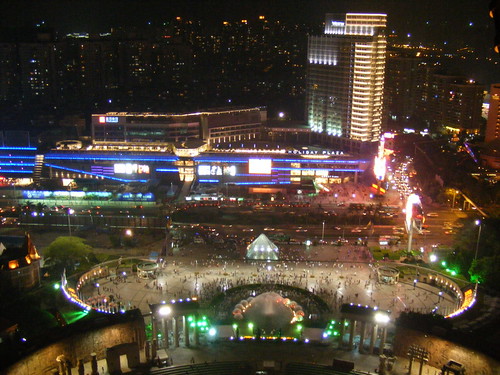 From the top of the faux Effiel Tower. The copy of the Pei entrance to the Louvre is the entrance to the Metro.
From the top of the faux Effiel Tower. The copy of the Pei entrance to the Louvre is the entrance to the Metro.
Hong Kong, as I said, is right across the Shenzhen River, and even after the turnover, once must pass through exit and entry customs when crossing from the Hong Kong Special Administrative Region to Mainland China. However, the process was simple, and involves a short walk between the Shenzhen Metro to the former Kowloon-Canton Railway (now part of the MTR network).


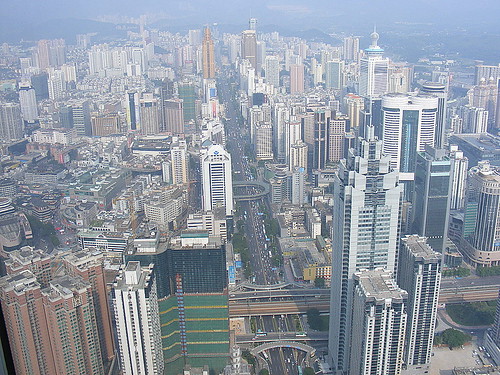
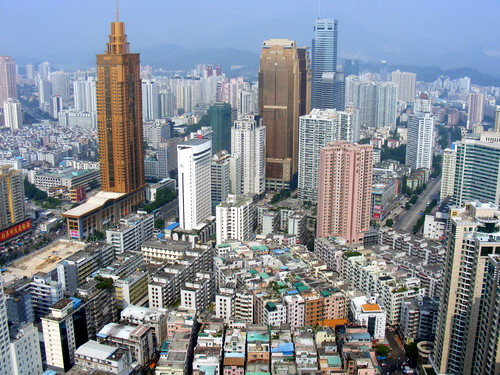
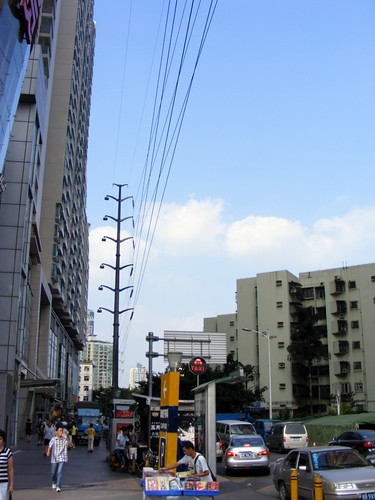
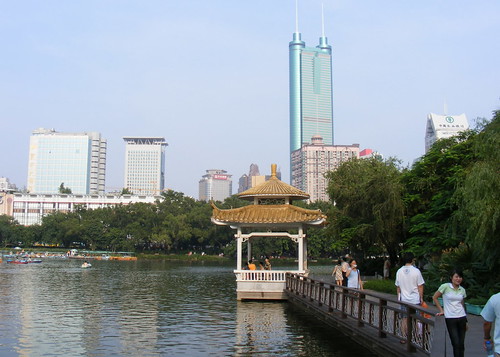
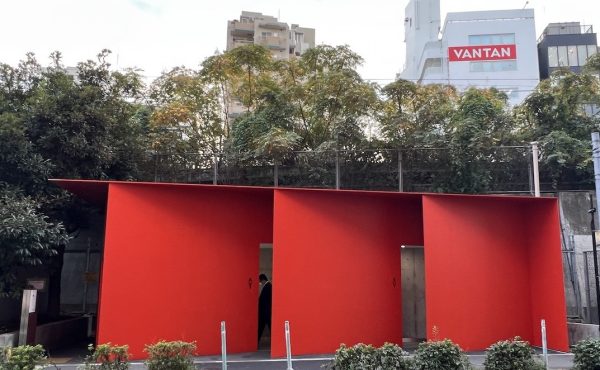
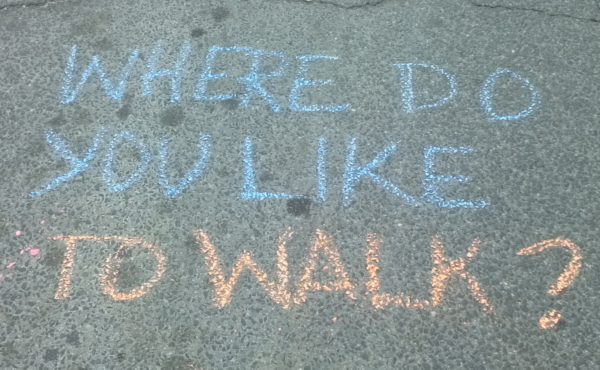
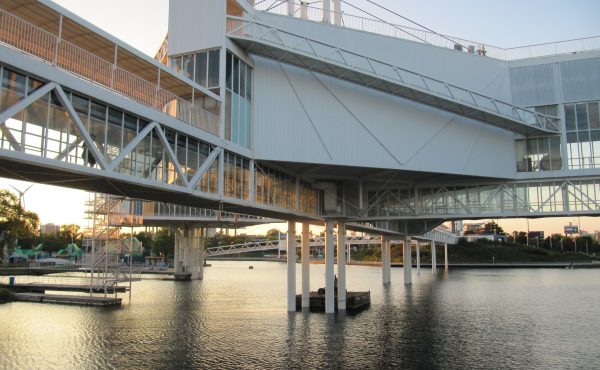
5 comments
Hey Sean!
I’m following your series on Chinese cities with great interest. Sorry I don’t really have much to write about Changchun or Dalian because I don’t really know much about them, but I will comment about Shenzhen based on what I know.
I tend to see the proliferation of pedestrian overpasses in Shenzhen more as an attempt to emulate Hong Kong than the US. In Hong Kong (and much of China today), transportation planners are keen to segregate different modes of transportation. Cars should only belong on the road. Pedestrians should only be on the sidewalk or on a dedicated overpass/tunnel. Bikes should only stay in designated bike lanes. On many major streets in Hong Kong and China there are fences and barriers that keep pedestrians off the streets and discouraging them from crossing the street at street level. I think that this segregation is done not to make the car “king” but rather to make the streets safer for pedestrians, since many Chinese are jaywalkers and have little regard for pedestrian signals (Go to Spadina and Dundas and you might see what I mean).
One major reason why factories and workers’ dormitories are located away from central Shenzhen is because the Shenzhen Special Economic Zone (SEZ) is, according to China’s “hukou” or internal passport system, a closed city for most migrant workers. Checkpoints are set up on major roads at the border of the SEZ, allowing only those permitted to work/live in Shenzhen and foreigners (including Hong Kong residents) to enter the SEZ, while turning unauthorized persons away.
Here’s a satellite image on Google Maps of the checkpoint on the Guangshen (Guangzhou-Shenzhen) Expressway at the SEZ border:
http://maps.google.com/?ie=UTF8&ll=22.571937,113.918921&spn=0.002402,0.006866&t=h&z=18
Looking forward to reading your piece about my hometown!
My memory of my last visit to Shenzhen in 2007 included a full spa package including a 3 hour body massage for roughly $10 CAD including tip. And this wasn’t one of those happy ending types either.
Now that is luxury.
Yeah Laurence, amazing the deals slave-wages can get a first-worlder. Good for you!
Wylie:
Except on a very few roads, Changchun and Dalian did not have these barriers, and if they did, they were intended to force pedestrians to cross at signalized intersections. Granted Changchun is a much less wealthy city, though, but Hong Kong even has few of these inaccessible overpasses compared to Shenzhen.
I did pass through one of the checkpoints that you mentioned by car – perhaps the same one you mentioned on the Guangzhen Expressway (I got a ride from the airport), but we didn’t stop, it felt like a facility that random or intermittent spotchecks are undertaken. I also thought that the Chinese government relaxed the “hukou†system to a large extent, though I did see evidence of enforcement (passengers on the train to Dalian from Changchun asked to show ID, and was examined, but as soon as the guard saw my foreign passport, he waved me off without even looking inside). Otherwise, how would they find the labour to build all the towers and skyscrapers?
While there were certainly signs of urbanity (how could there not in a dense city of 8 million), it really felt like a city built for the car, like a hyper Los Angeles. There weren’t even that many bike lanes – in fact, the majority of bikes I saw were of the electric variety, and they will run you down on the sidewalk.
Yes James, it is amazing. You should take advantage of it too.